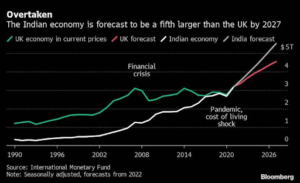In news– According to the latest calculations by Bloomberg, India has become the world’s fifth-largest economy after it overtook the United Kingdom in end-March 2022.
What does the Bloomberg report say?
- India has overtaken the U.K. to become the world’s fifth-largest economy and is now behind only the US, China, Japan and Germany.
- A decade back, India was ranked 11th among the large economies while the U.K. was at the fifth position.
- With record beating expansion in the April-June quarter, the Indian economy has now overtaken the U.K., which has slipped to the sixth spot.
- The report revealed that on an adjusted basis and using the dollar exchange rate on the last day of the relevant quarter, the size of the Indian economy in ‘nominal’ cash terms in the quarter through March was $854.7 billion. On the same basis, UK was $816 billion
- It has said that there is likely to be a huge gap between India and the UK within the next few years.

- Bloomberg reached this conclusion by using the IMF database and historic exchange rates.
- As of 2022, India has a population of 1.41 billion while the UK’s population is 68.5 million. In other words, India’s population is 20 times that of the UK’s.
- Since there is such a stark difference between the population of the two countries, GDP per capita provides a more realistic comparison of income levels because it divides a country’s GDP by the population of that country. The income of an average Indian is far lower.
- Low per capita incomes often point to high levels of poverty. It is noteworthy that at the start of the 19th century, the UK’s share in extreme poverty was considerably higher than India’s.
- When it comes to the Human Development Index. India stands on HDI with the UK’s. Despite its secular improvement, India might still take a decade to be where the UK was in 1980.
- A crucial element of becoming richer as a country is the quality of life available to citizens.
- The Universal Health Coverage (UHC) Index is measured on a scale from 0 (worst) to 100 (best) based on the average coverage of essential services including reproductive, maternal, newborn and child health, infectious diseases, non-communicable diseases and service capacity and access.
Source: The Indian Express
















